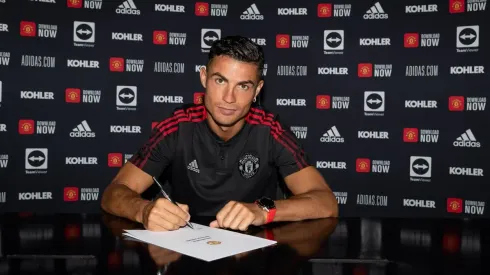Think about the first time you heard the name Erling Haaland. It was probably some time around 2019, when he scored nine goals against Honduras in the FIFA U-20 World Cup or when he started to put his name on the global soccer scene by establishing himself as a true menace in the UEFA Champions League with Red Bull Salzburg.
Now, think about how many times you’d heard rumors about Haaland joining other teams, even before he signed for Borussia Dortmund at the end of 2019, remaining at the club for approximately two and a half years. There were rumors of him joining Manchester United, Chelsea, Barcelona, Juventus, and every other club in Europe, but at the end he signed for Manchester City.
The transfer itself was confirmed in May 2022, but Haaland can’t be registered as a Premier League player just yet, since the Summer window for clubs in that league doesn’t open until June 10. But if Haaland had been signed for a La Liga club, he would’ve had to wait until July 1 to be registered, and the same if he had signed for another Bundesliga club. Up next, the transfer windows of some of the world’s top leagues, explained.
Premier League

Photo by Tom Flathers/Manchester City FC via Getty Images
The Premier League transfer window opens on June 10 2022 and closes at 23:00 BST on September 1 2022, as do many other European leagues.
Transfers in the Premier League only become official after the FIFA Transfer Matching System (TMS) is active. The TMS is an online system, per FIFA, “that makes international transfers of players between clubs quicker, smoother and more transparent”.
How does the TMS work? The FIFA Legal & Compliance Division administers the Regulatory Enforcement Department, which in turn runs the TMS.
“The department contributes towards the growth and improvement of the football transfer market by simplifying and standardizing transfer processes. Based on FIFA’s knowledge of transfers, regulations and technology, the department is committed to developing high-quality products and services designed to meet stakeholder and customer needs”, according to FIFA.
How is a transfer approved by the Premier League? First, the transfer is subject to both the Premier League and the Football Association rules. If an issue arises, the Premier League contacts clubs involved to collect necessary information to clear up said issue. Some transfers, according to the Premier League page, also need FIFA approval.
What about international players? If you’ve ever heard of a South American player waiting for his “work permit” to play in the Premier League, it’s because people with passports that don’t belong to the European Union and the European Economic Area need special permits to work in the UK. Clubs need to apply for said permits before transfer windows close.
Who or what decides whether a player is approved for a work permit? The UK Home Office, the government department that deals with immigration, amongst other topics. They have a points-based system that, if a player meets, grants them the work permit. If players don’t meet the points system, they can apply for one at the Football Association Exceptions Panel, that will take the player’s experience into consideration when deciding whether or not to grant a work permit.
How do clubs send documents to the Premier League? “Clubs have a number of options in which to send documents through to the Premier League.This is helpful to the clubs because they might be having difficulty in getting through with one of the methods.The fax machine has been retired but clubs have the option of sending desktop faxes and scanned documents via email”, via the League itself.
La Liga Santander

(Photo by David S. Bustamante/Soccrates/Getty Images)
La Liga Santander, Spain’s first division, starts its summer transfer window on July 1 2022 and ends it on August 31 2022. Clubs have approximately eight weeks to sign new players, but can still make free agent signings after August 31, as well as incoming or outgoing loan deals. Many of the rules between leagues are fairly interchangeable, such as clubs and players sending important documents in order to get the transfers approved, but Spain has a specific platform to complete transfers.
LaLiga Manager is an online software that has been in place since the summer of 2016, and is used by Spanish clubs to finalize every transfer. How does it work? LaLiga Manager is an information hub where clubs submit every document required to go through a transfer, in a “precise and verifiable fashion”, according to LaLiga. The point of the software is to reduce the time it takes to finalize transfers and helps clubs maintain financial responsibility. It does so since LaLiga Manager includes every FIFA and UEFA rule regarding transfers, including whether a free agent earns a special signing bonus, or if a release clause is activated.
Every transfer in LaLiga is also subject to Control Económico, literally translated to English as Economic Control, which is a financial framework that clubs are subjected to in order to maintain fair competition. Akin to Financial Fair Play, the main difference is that Control Económico is a preventative measure, instead of a punitive one. This is what prevented Barcelona from keeping Lionel Messi, since one of its main pillars is to restrict the amount of money a team can spend on their team sheet, in order to maintain a healthy salary – turnover ratio.
Bundesliga

Robert Lewandowski of Munich lifts The Bundesliga Meisterschale trophy following their sides finish as Bundesliga champions after the Bundesliga match between FC Bayern München and VfB Stuttgart at Allianz Arena on May 08, 2022 in Munich, Germany. (Photo by Markus Gilliar/GES-Sportfoto via Getty Images)
The Bundesliga summer transfer window opens on July 1 2022 and closes at t 5:00 p.m. BS on September 1 2022. Similar to most European leagues, clubs can still sign free agents or agree loan deals for players after the deadline. The winter transfer window duration is the entirety of January.
This is how Bundesliga transfers work, according to the League itself:
1. Contact: An agreement is reached between the player in question and his new club.
2. Paperwork: The club then sends a request via email or fax to the German Football League (DFL) for the player to be added to the official transfer list. The player and his current club must sign this form.
3. Submission: The forms are examined by the players’ department of the DFL.
4. Registration: If all the requirements have been fulfilled, the player is added to the DFL’s player database.
5. Condition: The transfer can only be finalized once the player is added to the official transfer list.
6. Publication: The transfer list is made available on bundesliga.com.
After said steps are finalized, contract details are submitted by the new club to the DFL. But how exactly do German clubs do so? Through the Transfer Online Registration System (TOR). Similarly to LaLiga’s platform, the TOR is an online hub where Bundesliga and Bundesliga 2 teams go through every little transfer minutiae.
Through the platform, clubs enter information regarding transfers and contract extensions, and submit important documents to the DFL. The TOR has been implemented since the 2015/16 season, and its main purpose is to “work paper-free”, according to the league.
“The system is also more transparent, because all clubs know exactly what the processing status of their applications is. In addition, TOR means that all information is collected at a central point and can be accessed at any time. This also allows the DFL to generate reports in the system on the basis of all available data”, as explained here.
Clubs usually need to submit between eight to ten documents to the league to finalize a single transfer.
Ligue 1

Neymar Junior of Paris Saint Germain during the Ligue 1 Uber Eats match between Paris Saint Germain and ESTAC Troyes at Parc des Princes on May 8, 2022 in Paris, France. (Photo by Tnani Badreddine/vi/DeFodi Images via Getty Images)
The Ligue 1 summer transfer window, similarly to that of the Premier League, opens on June 10 2022 and closes at 11:59 p.m. BST on September 1 2022. There are two steps to announcing transfers in the French top division: first, transfers announced by the clubs are posted on the official Ligue de Football Professionnel (LFP) page. Then, they are posted in bold when approved by the league’s Legal Commission and the Direction Nationale du Contrôle de Gestion (DNCG).
Ligue 1 uses FIFA’s TMS as well, which is an online system, as explained above, “that makes international transfers of players between clubs quicker, smoother and more transparent”. Ligue 1’s winter transfer window, similar to that of the Bundesliga, runs through the entirety of January. Here are all the confirmed transfers, according to Transfermarkt, for the summer transfer window in France.
Liga MX

Alexis Vega of Chivas celebrates after scoring his team’s fourth goal during the playoff match between Chivas and Pumas UNAM as part of the Torneo Grita Mexico C22 Liga MX at Akron Stadium on May 8, 2022 in Zapopan, Mexico. (Photo by Alfredo Moya/Jam Media/Getty Images)
Liga MX’s summer transfer window is very different than that of major European leagues; this year, it shouldrun from June 14 until September 5, based on last year’s dates. Liga MX uses an online hub similar to that of the Bundesliga or LaLiga to finalize transfers. Named Sistema de Integral de Información Deportiva (SIID), it serves as the home for all legal documents and processes related to new transfers in the Mexican top flight.
Liga MX has two different approaches to transfers. The first relates to those of Mexican players. For the upcoming Apertura 2022, clubs can list Mexican players they are considering selling or loaning on the SIID, starting approximately on June 21 and ending on July 16 (dates based on last year’s transfer window).
The second relates to signing international players. Last year, with official dates to be confirmed for 2022, players had until September 22 to be registered with clubs. Liga MX starts at the end of July, which means that clubs could play a little over a third of the league campaign and still sign new players. The same applies for the winter transfer window, with the limit date being February 1 for a tournament that usually ends in May. International player transfers are subject to FIFA regulations.
Now, imagine a team sells a player once the Liga MX tournament is already underway. According to league regulations, said team can sign another player, as long as the player transferred to another league has played at least one full Liga MX tournament. The club looking for a replacement player needs to prove to the League that they have no salary or transfer debts.
Liga MX clubs can also register an additional four players per season, and can only play them as long as one of their other players suffer a season-ending injury. Clubs can register no more than 10 international players, per Liga MX rules and regulations.
Major League Soccer

Nashville team members celebrate after Nashville SC defender Dave Romney (4) scores during the MLS match between Real Salt Lake and Nashville SC at GEODIS Park in Nashville, TN on May 08, 2022. (Photo by Kevin Langley/Icon Sportswire via Getty Images)
Major League Soccer (MLS) is another league whose rules are very different than others around the globe. The United States top flight has two transfer windows. This year, the first ran from February 10 until May 4, while the second will run from July 7 until August 4.
MLS clubs can register up to 30 players on their rosters, and all of them can play during the regular season and playoffs, according to the League. Other than the different transfer window dates, MLS roster regulations are what separate the league from others.
First, clubs have a designated Salary Budget by MLS. In 2022, that number was $4,900,000, which means that said money can only be spent on up to 20 of the 30 players on the roster. The first 20 players are known as the club’s Senior Roster, but clubs can spend their $4,900,000 on only 18 of their players, instead of the full 20.
Then, clubs need to prove to MLS that they are “roster and budget compliant”, according to the League, by an established date, which in 2022 was February 25. Clubs can no longer restier players after September 2, which means that no more changes can be made from said date until the day after the MLS Cup Final.
There are several categories on an MLS roster. The first one is Domestic Players, which means that a player is either a United States citizen, a permanent resident, or that qualifies as a Homegrown International Player. Homegrown International Players are those who were members of an MLS club academy in either the United States or Canada. MLS teams can have as many Domestic Players as needed.
MLS provides all 28 clubs a total of 224 international roster spots, which are all tradable. THis means that some clubs can have more than eight spots, and some can have less than eight. “There is no limit on the number of international roster slots on each club’s roster.”, according to MLS.
Teams in the top U.S. division can also register Homegrown Players, three Designated Players, and Young Designated Players (23 years old or younger).
To access FIFA’s Worldwide registration periods calendar, click HERE.





